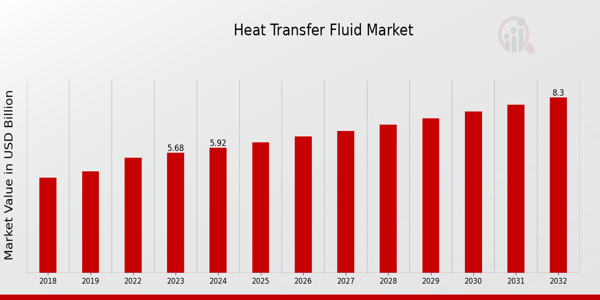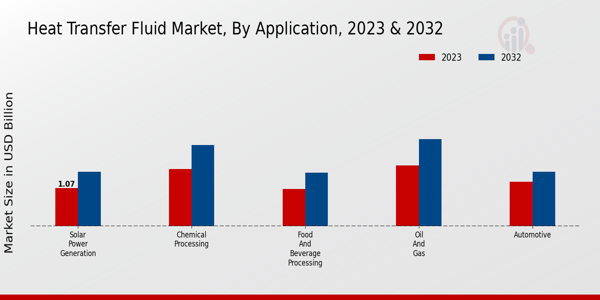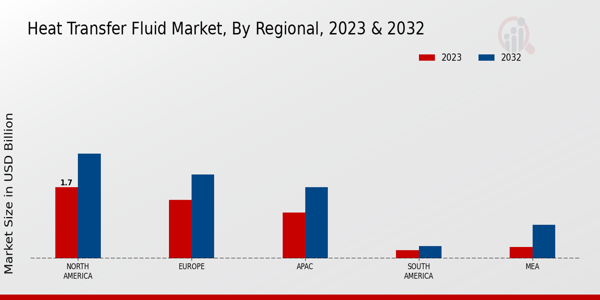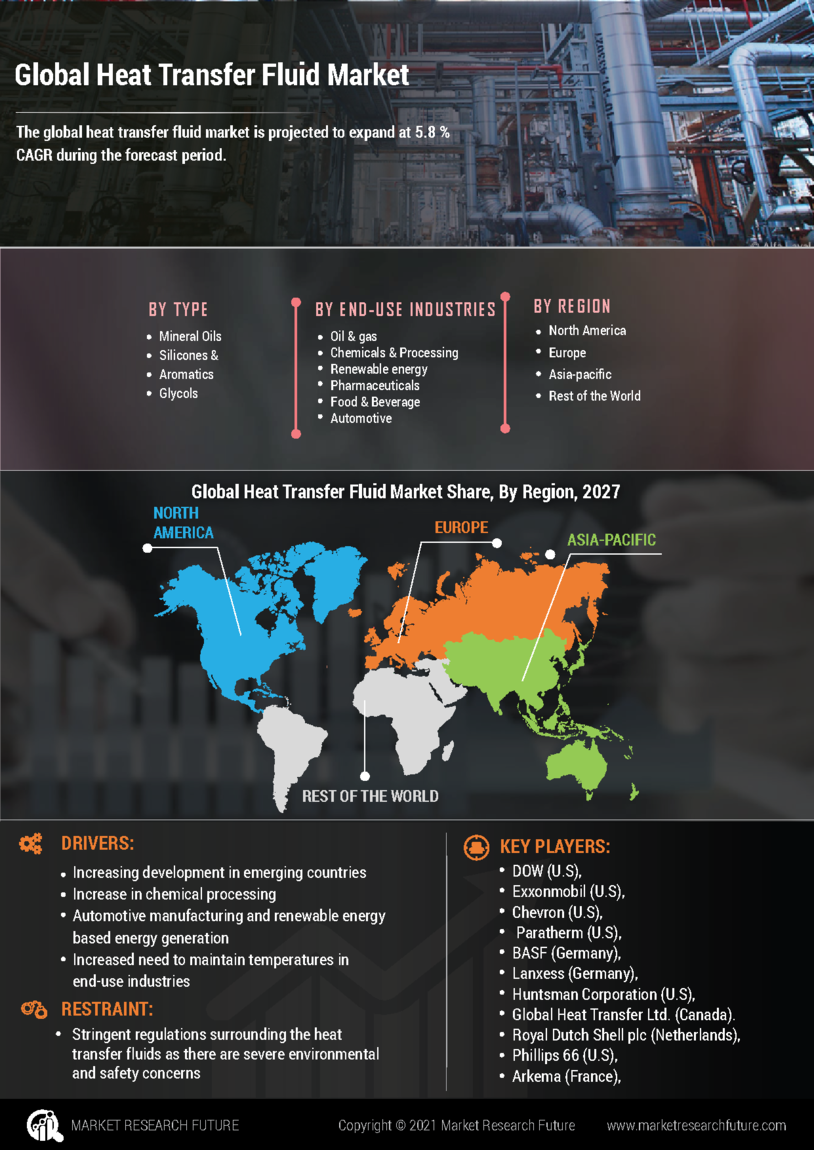Heat Transfer Fluid Market Summary
As per Market Research Future analysis, the Heat Transfer Fluid Market was valued at 5.45 USD Billion in 2022 and is projected to grow from 5.68 USD Billion in 2023 to 8.3 USD Billion by 2032, reflecting a CAGR of 4.3% during the forecast period (2024 - 2032). The market is driven by increasing demand for thermal management solutions across various industries, particularly in renewable energy, chemical processing, and automotive sectors.
Key Market Trends & Highlights
The global heat transfer fluids market is experiencing significant growth driven by technological advancements and increasing industrial applications.
- The Chemical Processing segment generated a market valuation of 1.6 USD Billion in 2023.
- Solar Power Generation is valued at 1.07 USD Billion, reflecting the shift towards renewable energy.
- The Oil and Gas sector holds a market value of 1.71 USD Billion in 2023, emphasizing its critical role in thermal applications.
- Synthetic Fluids are gaining traction due to their superior stability and efficiency under extreme temperatures.
Market Size & Forecast
2022 Market Size: USD 5.45 Billion
2023 Market Size: USD 5.68 Billion
2032 Market Size: USD 8.3 Billion
CAGR (2024 - 2032): 4.3%
Largest Regional Market Share in 2023: North America.
Major Players
Key companies include Thermax, ExxonMobil, Chevron, Gibbs Thermal Products, Global Heat Transfer, Mellitou, Paratherm, Solvay, Dowtherm, Eastman Chemical, Glycol Solutions, Dow, Fuchs Lubricants, and BASF.
Key Heat Transfer Fluid Market Trends Highlighted
The global heat transfer fluids market is booming with increasing demand for thermal management solutions in industries such as chemical, food & beverage and renewable energy among others. In order to meet the rising demand and environmental regulations, the firms are switching to sophisticated thermal fluids. The benefits offered such as improved energy utilization and operational cost cutting minimizes heat loss making them essential in a wide array of applications. Particularly, the increasing use of concentrated solar power systems is benefiting the market further, because energy production in these systems is only viable if sufficient and effective heat transfer solutions can be implemented.
At the same time, the market for heat transfer fluids is ripe for disruption. The increased regulatory requirements aimed at green house gas emission reduction has resulted in the shift towards bio based fluids and hate-friendly solutions thus giving companies an opportunity to adapt to the changing environment. Moreover, there is a growing demand for specialized heat transfer fluids for electric vehicles and newer battery technologies that require effective thermal regulation. This shift toward a more diverse energy economy that seeks new energy sources will increase the need for new innovative fluid solutions to drive energy efficiencies, in turn allowing companies to maximize their market share.
Lately, there has been a considerable trend towards the adoption of synthetic heat transfer fluids that offer enhanced performance and durability in comparison with traditional options. The current trend of using multi-purpose fluids for high-temperature applications can be considered as a significant advancement, particularly for high performing thermal fluid demanding sectors. Besides, regional market factors are also shaping product developments as manufacturers customize their products for local regulatory and operational requirements. The ongoing advancements in the field of heat transfer continue to transform the boundaries of the market allowing a higher performance and efficiency at thermal management solutions.

Source: Primary Research, Secondary Research, Market Research Future Database and Analyst Review
Heat Transfer Fluid Market Drivers
Increasing Demand for Renewable Energy Sources
The Heat Transfer Fluid Market Industry is witnessing a significant increase in demand for renewable energy sources, particularly as countries strive to meet their energy transition goals. As the world shifts towards cleaner energy production methods, heat transfer fluids play a crucial role in various renewable energy systems such as concentrated solar power (CSP), geothermal, and biomass energy production. These fluids are essential for transferring and storing heat, thereby optimizing energy production efficiency.
The growing emphasis on sustainability and reducing carbon emissions highlights the importance of heat transfer fluids in harnessing renewable energy effectively. This shift not only contributes to energy diversification but also propels the market for heat transfer fluids, as industries seek fluids that ensure high thermal performance under diverse operational conditions. Moreover, advancements in thermal fluid technologies support the development of innovative solutions that enhance efficiency and minimize heat losses, further fuelling the growth of the Heat Transfer Fluid Market.
The gradual departure from fossil fuel-centric systems and the adoption of renewables is a key driver that influences market dynamics, creating opportunities for industry players to develop and market specialized heat transfer fluids tailored to the unique needs of renewable energy applications.
Rising Industrial Application
The deployment of heat transfer fluids in various industrial applications is a critical driver for the Heat Transfer Fluid Market Industry. Industries such as chemical processing, food and beverage, pharmaceuticals, and manufacturing require effective thermal management to optimize production processes. Heat transfer fluids are pivotal in facilitating operations like heating, cooling, and heat recovery. As industries strive for enhanced operational efficiency and reduced downtime, the demand for reliable and efficient heat transfer fluids continues to grow.
Companies are increasingly adopting premium-grade fluids that offer improved heat transfer capabilities and stability under high-temperature conditions, addressing safety and performance standards. Subsequently, this rising demand across multiple sectors contributes to the expansion of the heat transfer fluid market.
Technological Advancements in Heat Transfer Fluids
Technological advancements are revolutionizing the Heat Transfer Fluid Market Industry, leading to the introduction of innovative fluids with enhanced properties. Researchers and manufacturers are focused on developing synthetic fluids that exhibit superior thermal conductivity, stability, and compatibility with various equipment. These advancements enable industries to operate at heightened efficiency and minimize the risks associated with traditional fluids, which may have limitations in extreme conditions.
The constant evolution of technology fosters a competitive environment where companies strive to introduce upgraded and environmentally friendly options, which are increasingly favored in modern industrial applications. This ongoing technological innovation is a significant driver for market expansion as businesses seek improved solutions for managing heat transfer processes.
Heat Transfer Fluid Market Segment Insights:
Heat Transfer Fluid Market Application Insights
The Application segment of the Heat Transfer Fluid Market plays a crucial role in defining the market dynamics and revenue generation. In 2023, this segment collectively holds a significant market value with notable contributions from various applications. Among these, the Chemical Processing segment stands out, generating a market valuation of 1.6 USD Billion, which highlights its essential function in various industrial processes requiring efficient heat transfer. Solar Power Generation, valued at 1.07 USD Billion, is rapidly gaining importance as the world shifts towards renewable energy sources, making it a vital component for sustainable energy solutions. This sector is projected to witness significant growth, driven by increasing investments in solar technology and infrastructure.
Furthermore, the Food and Beverage Processing segment, with a valuation of 1.05 USD Billion, demonstrates its necessity in maintaining quality and safety standards while efficiently managing temperature control. The Oil and Gas sector also plays a critical role, holding a market value of 1.71 USD Billion in 2023, owing to its extensive use in thermal applications across extraction and refining processes. The market in this sector is driven by the ongoing demand for fossil fuels and the need for efficient thermal management systems to maximize production.
Lastly, the Automotive sector, valued at 1.25 USD Billion, is witnessing growth as manufacturers adopt advanced heat transfer fluids to optimize vehicle performance and enhance fuel efficiency. The increasing emphasis on sustainability within the automotive industry is expected to further elevate the demand for innovative heat transfer solutions. Overall, the Application segment of the Heat Transfer Fluid Market illustrates robust growth, driven by technological advancements, evolving industry requirements, and a global push toward energy efficiency. Each application presents unique characteristics that foster its expansion, thereby positioning the market for a trajectory of continued growth in the coming years.

Source: Primary Research, Secondary Research, Market Research Future Database and Analyst Review
Heat Transfer Fluid Market Type Insights
The Heat Transfer Fluid Market is projected to be valued at 5.68 USD Billion in 2023, with sustained growth expected through 2032. This sector is primarily segmented into types such as Synthetic Fluids, Mineral Oils, Water Glycol Solutions, and Thermal Oils, each playing a significant role in various industrial applications. Synthetic Fluids are gaining traction due to their superior stability and efficiency under extreme temperatures, making them ideal for advanced heat transfer systems. Mineral Oils, traditionally relied upon for their cost-effectiveness and availability, continue to hold a significant share due to their long-standing use in various thermal processes.
Water Glycol Solutions stand out for their low freezing points and suitability for systems exposed to cold environments, while Thermal Oils are favored for high-temperature applications due to their excellent thermal stability. Overall, the segmentation of the Heat Transfer Fluid Market reveals unique behaviors and preferences, steering innovation, and market growth, further indicated by evolving demand dynamics across industries. The increasing focus on energy efficiency, combined with the growing need for process optimization, drives the expansion of this market segment.
Heat Transfer Fluid Market End Use Industry Insights
The Heat Transfer Fluid Market is poised for significant growth, especially within the End Use Industry segment, which contributes considerably to its overall revenue. By 2023, the market is expected to be valued at 5.68 billion USD, showcasing robust demand across various sectors. Chemical industry plays a vital role in driving market growth due to its need for effective heat transfer in various processes. Similarly, the Oil and Gas sector is a major contributor, emphasizing the importance of heat transfer fluids in extraction and refining processes.
Manufacturing has also emerged as a critical area, with heat transfer fluids being integral for efficient production operations. The Renewable Energy sector is gaining traction as the focus on sustainable energy solutions rises, highlighting the opportunity for innovative heat transfer fluid applications. The Food and Beverage industry dominates with stringent thermal management requirements, underscoring its significance in maintaining product quality. These varied applications underscore the diversified nature of the Heat Transfer Fluid Market segmentation, providing numerous opportunities and challenges in ensuring efficiency and compliance across industries, thus shaping the future landscape of the market.
Heat Transfer Fluid Market Temperature Range Insights
The Heat Transfer Fluid Market, valued at 5.68 USD Billion in 2023, is segmented by Temperature Range, which includes Low Temperature, Medium Temperature, and High Temperature categories. Each of these segments plays a crucial role in various industries, with Low Temperature fluids often utilized in applications requiring minimal heat transfer loss, such as in refrigeration systems. On the other hand, Medium Temperature segments cater to needs in commercial heating processes and industrial applications, effectively balancing energy savings and performance.
High Temperature fluids dominate sectors like power generation and chemical processing, where efficiency is paramount. Market growth is driven by increasing industrial demand for efficient heat transfer solutions and innovation in fluid formulations to enhance performance. Despite potential challenges like regulatory compliance and the need for compatibility with existing systems, there are significant opportunities in emerging markets and advancements in thermal energy storage. The Heat Transfer Fluid Market Statistics suggest a robust growth trajectory, and understanding the Heat Transfer Fluid Market segmentation is vital to capitalize on these market dynamics.
Heat Transfer Fluid Market Regional Insights
The Heat Transfer Fluid Market is experiencing steady growth across its regional segment, with a market valuation of 5.68 USD Billion in 2023, expected to rise significantly over the coming years. North America dominates this segment, holding a valuation of 1.7 USD Billion in 2023 and projected to increase to 2.5 USD Billion by 2032, making it a key player due to robust industrial activities and energy demand. Europe follows closely with revenues of 1.4 USD Billion, anticipating growth to 2.0 USD Billion, driven by stringent regulations regarding energy efficiency and an increasing focus on renewable energy sources.
The APAC region, with a valuation of 1.1 USD Billion in 2023, is increasingly significant, predicted to reach 1.7 USD Billion by 2032, reflecting rapid industrialization and urbanization trends in countries like China and India. South America and the MEA show smaller valuations of 0.2 USD Billion and 0.28 USD Billion respectively in 2023, suggesting emerging opportunities as their industries develop. The overall market growth is bolstered by the increased reliance on heat transfer fluids across various applications, including chemical processing and power generation.

Source: Primary Research, Secondary Research, Market Research Future Database and Analyst Review
Heat Transfer Fluid Market Key Players and Competitive Insights:
The competitive landscape of the Heat Transfer Fluid Market is characterized by a diverse range of players that offer various products and services aimed at meeting the increasing demand for efficient thermal management solutions. The market is influenced by several factors, including rapid industrialization, the expansion of the power generation sector, and heightened focus on energy efficiency across various applications.
Companies in this market are leveraging advanced technologies and innovations to develop high-performance heat transfer fluids that cater to a variety of industries such as chemical processing, food and beverage, and renewable energy. As industry evolves, stakeholders are also prioritizing sustainability and environmental considerations, aiming to provide eco-friendly alternatives to traditional heat transfer fluids. Competitive dynamics are shaped by market leaders striving to differentiate themselves through product quality, customer service, and innovative applications, which ultimately drive market growth and enhance competitive positioning.
Thermax has positioned itself strongly in the Heat Transfer Fluid Market through its focus on providing tailored thermal solutions and a robust portfolio of heat transfer products. The company stands out due to its commitment to innovation, which is reflected in its continuous research and development efforts to improve fluid performance and efficiency. This emphasis on quality allows Thermax to address the diverse needs across industries such as food processing and textiles, ensuring they meet specific operational requirements while adhering to environmental regulations.
Thermax's extensive experience in thermal engineering and customer-centric approach further bolster its market presence, enabling it to establish long-term relationships with clients. The company’s strategic initiatives, including partnerships and collaborations, also enhance its ability to expand its product reach and strengthen its competitive advantage, making it a significant player in the heat transfer fluid sector.
ExxonMobil is a well-established entity within the Heat Transfer Fluid Market, recognized for its extensive expertise in developing innovative and high-quality heat transfer fluids. With a strong emphasis on research and development, ExxonMobil continues to advance its product offerings, focusing on enhancing thermal efficiency and extending fluid longevity, which are critical factors for industries relying on high-temperature processes. The company's global reach and firm standing in the energy market allow it to leverage synergies and apply best practices across various sectors, resulting in effective solutions tailored to meet the diverse requirements of its clientele.
ExxonMobil’s reputation for reliability and superior performance, along with its commitment to sustainability and environmentally friendly formulations, positions it favorably against competitors in the heat transfer fluid market. This strategic focus on product excellence and customer satisfaction helps ExxonMobil maintain a competitive edge and fulfill the growing demands of the industry.
Key Companies in the Heat Transfer Fluid Market Include:
Heat Transfer Fluid Industry Developments
-
Q2 2024: Dow to invest $65 million to expand heat transfer fluid production in Texas Dow announced a $65 million investment to expand its heat transfer fluid manufacturing facility in Freeport, Texas, aiming to meet growing demand from the renewable energy and industrial sectors.
-
Q2 2024: BASF launches new high-performance heat transfer fluid for solar thermal applications BASF introduced a new heat transfer fluid specifically designed for concentrated solar power plants, enhancing thermal stability and efficiency at high operating temperatures.
-
Q3 2024: Eastman Chemical appoints new VP for Heat Transfer Fluids business Eastman Chemical named Dr. Lisa Chen as Vice President of its Heat Transfer Fluids division, signaling a strategic focus on innovation and global expansion.
-
Q3 2024: Honeywell partners with Siemens to develop next-generation heat transfer fluids for industrial automation Honeywell and Siemens announced a partnership to co-develop advanced heat transfer fluids optimized for use in automated manufacturing and process industries.
-
Q4 2024: Clariant opens new heat transfer fluid R&D center in Switzerland Clariant inaugurated a research and development center dedicated to heat transfer fluids in Basel, Switzerland, to accelerate product innovation and sustainability initiatives.
-
Q4 2024: Shell signs supply contract for heat transfer fluids with major European solar developer Shell secured a multi-year contract to supply heat transfer fluids to a leading European solar power developer, supporting the expansion of large-scale solar thermal projects.
-
Q1 2025: Dow completes acquisition of specialty heat transfer fluids business from Solvay Dow finalized its acquisition of Solvay's specialty heat transfer fluids business, expanding its product portfolio and strengthening its position in the global market.
-
Q1 2025: ExxonMobil launches bio-based heat transfer fluid for food processing industry ExxonMobil introduced a new bio-based heat transfer fluid targeting the food processing sector, offering improved safety and environmental performance.
-
Q2 2025: INEOS announces $100 million investment in new heat transfer fluid plant in Belgium INEOS revealed plans to invest $100 million in constructing a new heat transfer fluid manufacturing facility in Antwerp, Belgium, to serve European industrial customers.
-
Q2 2025: Honeywell secures contract to supply heat transfer fluids for Middle East solar project Honeywell was awarded a contract to provide heat transfer fluids for a major solar thermal project in the Middle East, supporting regional renewable energy goals.
-
Q3 2025: BASF and TotalEnergies form joint venture for sustainable heat transfer fluids BASF and TotalEnergies established a joint venture to develop and market sustainable heat transfer fluids, focusing on renewable energy and industrial applications.
-
Q3 2025: Eastman Chemical expands heat transfer fluid production capacity in Singapore Eastman Chemical completed an expansion of its Singapore facility, increasing production capacity for heat transfer fluids to meet rising demand in Asia-Pacific.
Heat Transfer Fluid Market Segmentation Insights
Heat Transfer Fluid Market Application Outlook
- Food and Beverage Processing
Heat Transfer Fluid Market Type Outlook
Heat Transfer Fluid Market End Use Industry Outlook
Heat Transfer Fluid Market Temperature Range Outlook
Heat Transfer Fluid Market Regional Outlook
|
Attribute/Metric
|
Details
|
|
Market Size 2022
|
5.45 (USD Billion)
|
|
Market Size 2023
|
5.68 (USD Billion)
|
|
Market Size 2032
|
8.3 (USD Billion)
|
|
Compound Annual Growth Rate (CAGR)
|
4.3% (2024 - 2032)
|
|
Report Coverage
|
Revenue Forecast, Competitive Landscape, Growth Factors, and Trends
|
|
Base Year
|
2023
|
|
Market Forecast Period
|
2024 - 2032
|
|
Historical Data
|
2019 - 2023
|
|
Market Forecast Units
|
USD Billion
|
|
Key Companies Profiled
|
Thermax, ExxonMobil, Chevron, Gibbs Thermal Products, Global Heat Transfer, Mellitou, Paratherm, Solvay, Dowtherm, Eastman Chemical, Glycol Solutions, Dow, Fuchs Lubricants, BASF, Heat Transfer Fluids
|
|
Segments Covered
|
Application, Type, End Use Industry, Temperature Range, Regional
|
|
Key Market Opportunities
|
Growing demand in renewable energy, Expansion in chemical processing industry, Advancements in automotive cooling systems, increasing energy efficiency regulations, Rising investments in thermal management technologies
|
|
Key Market Dynamics
|
increasing industrial applications, growing renewable energy sector, rising demand for efficiency, stringent environmental regulations, advancements in heat transfer technologies
|
|
Countries Covered
|
North America, Europe, APAC, South America, MEA
|
Heat Transfer Fluid Market Highlights:
Frequently Asked Questions (FAQ):
The Heat Transfer Fluid Market is expected to be valued at 8.3 USD Billion in 2032.
The expected CAGR for the Heat Transfer Fluid Market from 2024 to 2032 is 4.3%.
In 2032, North America is projected to have the largest market share, valued at 2.5 USD Billion.
In 2023, the market size for the Solar Power Generation application is valued at 1.07 USD Billion.
The key players in the Heat Transfer Fluid Market include Thermax, ExxonMobil, Chevron, and Dowtherm, among others.
The expected market size for the Food and Beverage Processing application in 2032 is valued at 1.51 USD Billion.
The projected market size for the Chemical Processing application in 2024 is anticipated to grow significantly from 1.6 USD Billion in 2023.
The Oil and Gas application is valued at 1.71 USD Billion in 2023.
The Asia-Pacific region is expected to reach a market size of 1.7 USD Billion in 2032, indicating significant growth potential.
Emerging trends include advancements in production technology and increased applications in renewable energy sectors.


















